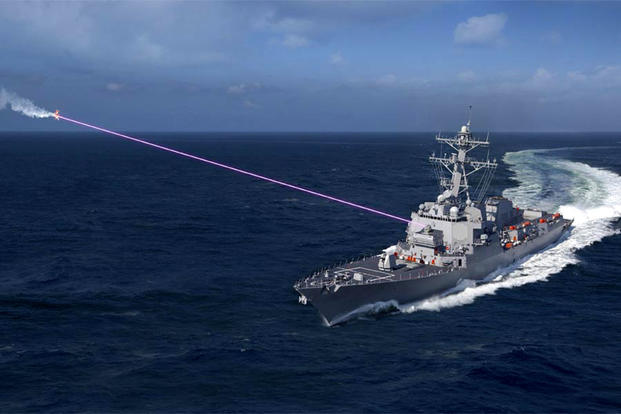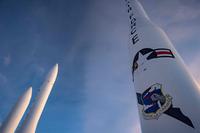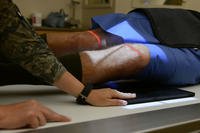The Navy has been working for over a decade on various efforts to equip warships with laser weapons that can confuse or destroy enemy systems. And while the service still doesn't have a ship laser that's ready for showtime, it's still investing heavily in the technology, with millions slated for multiple prototype and developmental weapons in the coming year.
The Navy's fiscal 2023 budget request calls for over $103 million to support a half-dozen laser weapon concepts, according to budget justification documents. This year, the service plans to mount a laser dazzler system on a guided-missile destroyer for testing, and lay the groundwork for experiments with another laser system designed to take out an anti-ship cruise missile. For ships that carry a limited number of missiles and rounds, the notion of an effective standoff weapon that won't run out of ammo is attractive. But critics wonder if the ship laser concept will ever live up to its stated promise.
"Skeptics sometimes note that proponents of high-energy military lasers over the years have made numerous predictions about when lasers might enter service with DOD, and that these predictions repeatedly have not come to pass," a Congressional Research Service (CRS) report published in April states. "Viewing this record of unfulfilled predictions, skeptics have sometimes stated, half-jokingly, that ‘lasers are X years in the future — and always will be.'"
The developments set to take place within the next 12 months may provide more insight into what the future truly holds for the concept.
Look to the sun
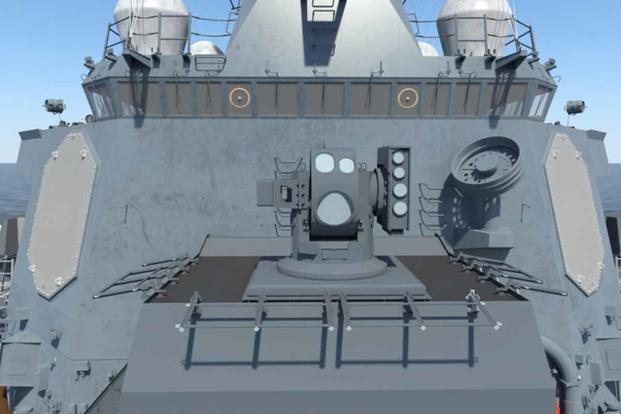
The first development to watch is the installation of the High-Energy Laser with Integrated Optical Dazzler and Surveillance, or HELIOS, on the destroyer USS Preble in San Diego, taking place now and set to wrap up before the end of the year. HELIOS, according to maker Lockheed Martin Corp., is a high-energy laser that can also act as a dazzler to take out enemy drone, and as a tool to support long-range intelligence, surveillance and reconnaissance.
"The HELIOS system's deep magazine, low cost per kill, speed of light delivery, and precision response enable it to address Fleet needs now and its mature, scalable architecture supports increased laser power levels to counter additional threats in the future," Lockheed states in program materials.
The company was first contracted in 2018 to begin building HELIOS. Seapower Magazine reported that the Navy believes it can operate the system consistently at 60 kilowatts, but scale it up to 120 kW with a few tweaks.
After installation of HELIOS is complete, the Navy wants to conduct at-sea testing of the system in fiscal 2023, according to budget documents. The roughly $19 million requested for this effort would also pay for engineering, maintenance and repair, and changes based on the results of at-sea testing.
HELIOS is similar in concept to one of the Navy's earliest ship laser efforts. In 2014, the service mounted a counter-drone weapon called the Laser Weapons System, or LaWS, onto the Afloat Forward Staging Base Ponce, a former amphibious ship, in the Persian Gulf. When Ponce was decommissioned in 2017, LaWS was brought ashore. According to the CRS briefing, it's going to be used as a land-based test asset for HELIOS development as that program moves forward.
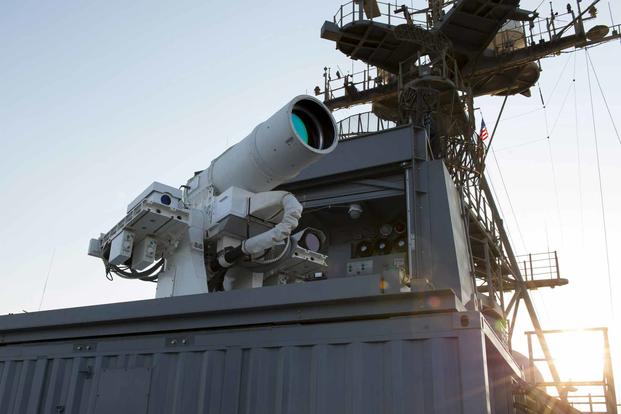
One obstacle for HELIOS may be system cost: CRS sites Navy estimates at $100 million per unit for early development. The cost of employing the system is supposed to be negligible – a couple of dollars per shot – but it's still not clear if the weapon as a whole is a good deal for the Navy.
"As the Navy continues to mature Laser Weapon Systems and analyze their integration into the overall combat system, the cost per kill metrics will be refined to specify adequate return on investment," CRS wrote in its report. "Given the current uncertainty in relative contributions of the various systems being evaluated and the sensitivity to doctrinal implementation and logistic assumptions, it is too early to assign a meaningful value that can be attributed purely to the implementation of laser weapon systems."
Laser weapons versus missiles
Two other laser weapons in development are the Navy's Optical Dazzling Interdictor, or ODIN, and the High Energy Laser Counter-[Anti-Ship Cruise Missile] Program, or HELCAP.
ODIN was spotted quietly installed for testing onboard the destroyer USS Stockdale in 2021. The Navy wants $25 million for testing and development of the system in fiscal 2023, up from $9 million this year. Those funds will provide for shipboard support and maturation efforts. The Navy has said it plans to have the systems installed onboard eight destroyers in all, with that installation effort reportedly set to be completed next year.
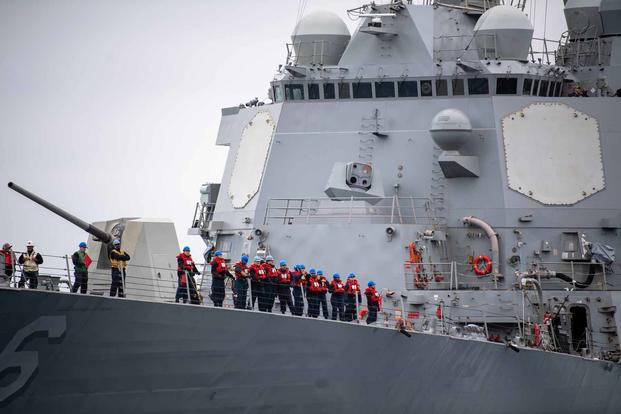
Intended to confuse enemy drones and other sensing systems, ODIN was designed and built by the Navy from the ground up. It's not clear how widely the service plans to employ the system within its destroyer fleet once the weapon is operational.
The last of the laser weapon trio, HELCAP, is the most powerful of the three, with at least 300 kW to defeat incoming anti-ship cruise missiles. Documentation also suggests it faces the most technological and development challenges. The Navy wants about $7 million for the HELCAP in fiscal 2023, down from $25 million this year. It's pushing back experimentation plans until at least 2024 due to "technology maturation" challenges, documents state.
According to documents released, among those challenges are high atmospheric turbulence, target tracking accuracy, and "jitter control."
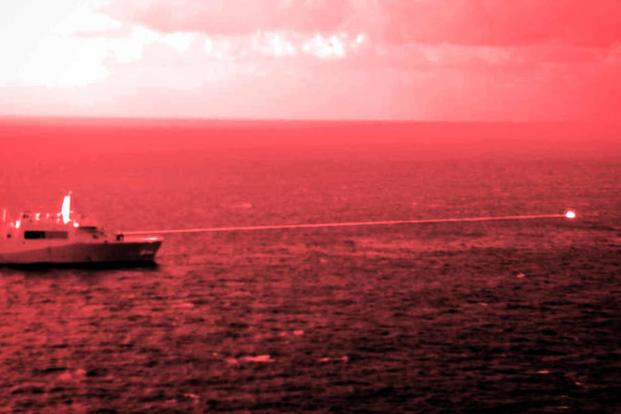
Key next steps for HELCAP are set to take place at Naval Surface Warfare Center Dahlgren, Maryland, which is tasked with designing and building auxiliary power and cooling systems.
"FY23 activities will culminate with this demonstration and preparation for targeting and tracking limited maritime experimentation planned for FY24," the Navy's budget request states.
The Navy is also experimenting with ground-based laser weapons. In a test earlier this year, a system called Layered Laser Defense (LLD) from Lockheed Martin shot down a target drone that was meant to simulate a subsonic cruise missile.
"Innovative laser systems … have the potential to redefine the future of naval combat operations," Chief of Naval Research Rear Adm. Lorin C. Selby said at the time. "They present transformational capabilities to the fleet."
Ultimately, the Navy envisions these ship-based systems working together as a family of laser weapons that can provide effective renewable defense for surface ships at a fraction of the cost-per-kill of conventional weapons. It's still not clear, however, when that vision will become reality. But as testing and installation move forward with specific, finite objectives, the integration of lasers into naval warfare is closer to reality than it's ever been.
Hope Hodge Seck is an award-winning investigative and enterprise reporter who has been covering military issues since 2009. She is the former managing editor for Military.com.
Read the original article on Sandboxx
